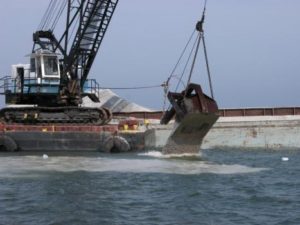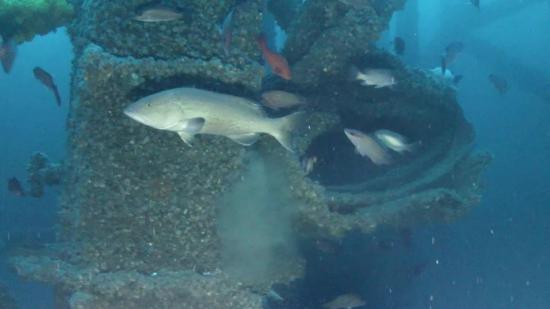The first work has begun on four new Louisiana inshore artificial reefs, increasing hard bottom habitat and removing it from oyster harvesting, the state Department of Wildlife and Fisheries announced Tuesday.
The Lake Borgne Shell Pad, Grand Banks, West Karako Bay and Cabbage Reef artificial reef sites started out with 880 tons of limestone, 130 reef balls – prefabricated, perforated concrete domes – and 80 cubic yards of recycled oyster shells.
The department “will continue to develop reefs that enhance fish habitat while providing excellent recreational fishing opportunity for our inshore anglers,” said state wildlife Secretary Jack Montoucet. “We would like to thank our partners at the Lake Pontchartrain Basin Foundation for their efforts on this project as well.”

Limestone being deployed by barge on an inshore artificial reef site. Louisiana Department of Wildlife and Fisheries photo.
Designed across a range of salinities, the new reefs are “within the optimum range for popular recreational saltwater species like speckled trout, redfish, and flounder,” according to the wildlife agency.
They are also restricted from oyster harvest – a step state officials say is necessary for them “to serve as a source of oyster broodstock and continue to assist the nearby oyster population for the future.” That rule stands for all of the state’s 30-plus inshore artificial reef sites.
These reefs are being in partnership between the state and the Lake Pontchartrain Basin Foundation, which has assisted previously in building seven other reefs in that region.
“The reefs will disrupt currents in these waterways and provide critical hard structure, allowing better habitat for bottom-dwelling organisms,” foundation executive director Kristi Trail said in a joint statement issued with Montoucet’s agency. “These invertebrates form the base of the food web and support larger species, including sport fish.”
Louisiana’s artificial reef program began in 1986 and has used material from decommissioned offshore oil and gas rigs to build 71 offshore reef sites, which general are in waters of at least 100-foot depths. Offshore energy companies that save money through the program are required to donate a portion to the state to contribute toward inshore reef construction as well.







